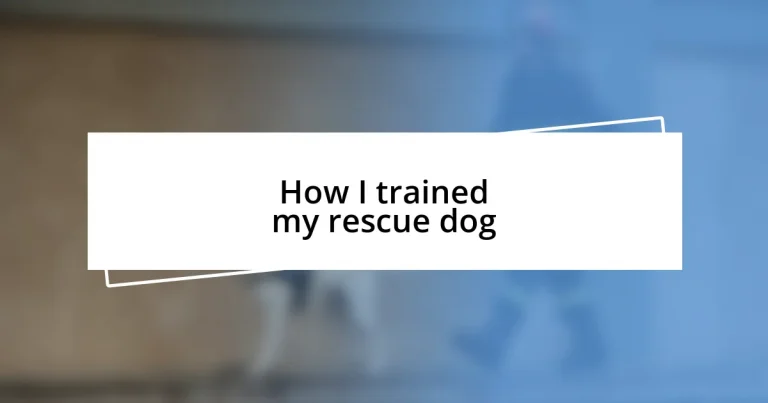Key takeaways:
- Choosing the right rescue dog involves considering temperament, energy level, and the dog’s background, as these factors significantly impact behavior and training.
- Establishing a consistent training schedule with short, engaging sessions and integrating training into daily life activities can strengthen the bond between the owner and the dog.
- Using positive reinforcement methods enhances training effectiveness by building trust and encouraging desired behaviors, while monitoring progress allows for adapting strategies based on the dog’s responses.
- Socialization in controlled environments is crucial for helping rescue dogs gain confidence and comfort with new experiences and interactions.
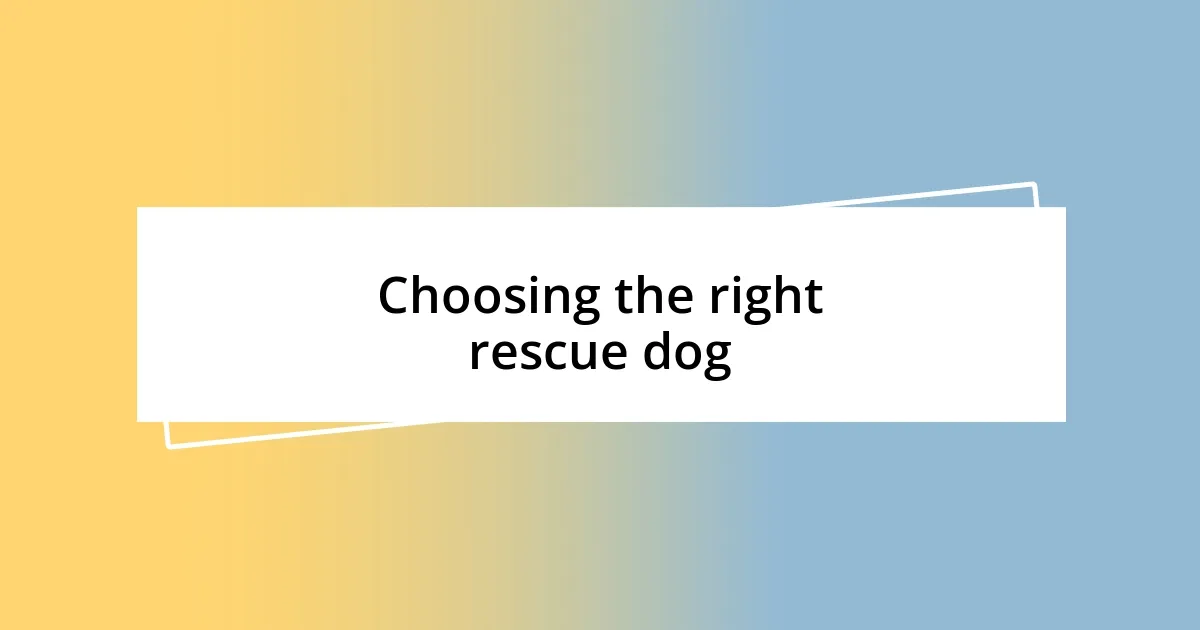
Choosing the right rescue dog
When I first walked into the shelter, I was overwhelmed by the sheer number of dogs wagging their tails, each with a story to tell. How do you even begin to choose? I remember standing there, paralyzed by the possibilities and yet instinctively drawn to a gentle soul who seemed to need my love as much as I needed his.
It’s crucial to consider not just how a dog looks but its temperament and energy level. For instance, I was looking for a couch companion, so I gravitated towards the more laid-back dogs. On the other hand, if you lead an active lifestyle, you might want to seek out those enthusiastic pups ready to hit the trails with you. What type of dog matches your rhythm?
Another important factor is assessing past experiences of the dog. I found that connecting with the staff provided invaluable insights—they often know which dogs have been more adaptable or resilient. Have you ever thought about how a dog’s history can impact its training? It’s a vital piece of the puzzle that can shape your journey together.

Understanding your dog’s background
Understanding your dog’s background is fundamental to building a strong bond. When I adopted Max, I learned he had been found wandering the streets, scared and alone. This history explained his initial hesitance and the moments when he would flinch at sudden movements. Recognizing these signs helped me approach him with patience and understanding.
Every dog’s background is unique, and it influences their behavior and response to training. I’ve always believed that knowledge is power. Unearthing details about Max’s past—from his previous living conditions to the experiences he faced—allowed me to tailor my training methods effectively. Did you know that a dog who’s had a rough start may need extra reassurance? This understanding prompted me to use gentle voice commands and plenty of positive reinforcement.
As I delved deeper into Max’s history, I discovered the importance of empathy. His frequent hiding whenever loud noises occurred became clearer once I learned he had been scared by fireworks in his previous home. Each revelation was like piecing together a puzzle, allowing me to create a nurturing environment where he felt safe. How could I have supported him without this knowledge?
| Dog’s Background | Impact on Behavior |
|---|---|
| Abandoned | Can lead to anxiety and fearfulness towards humans |
| Abused | May exhibit trust issues, aggression, or withdrawal |
| Stray | Often requires socialization and basic training |
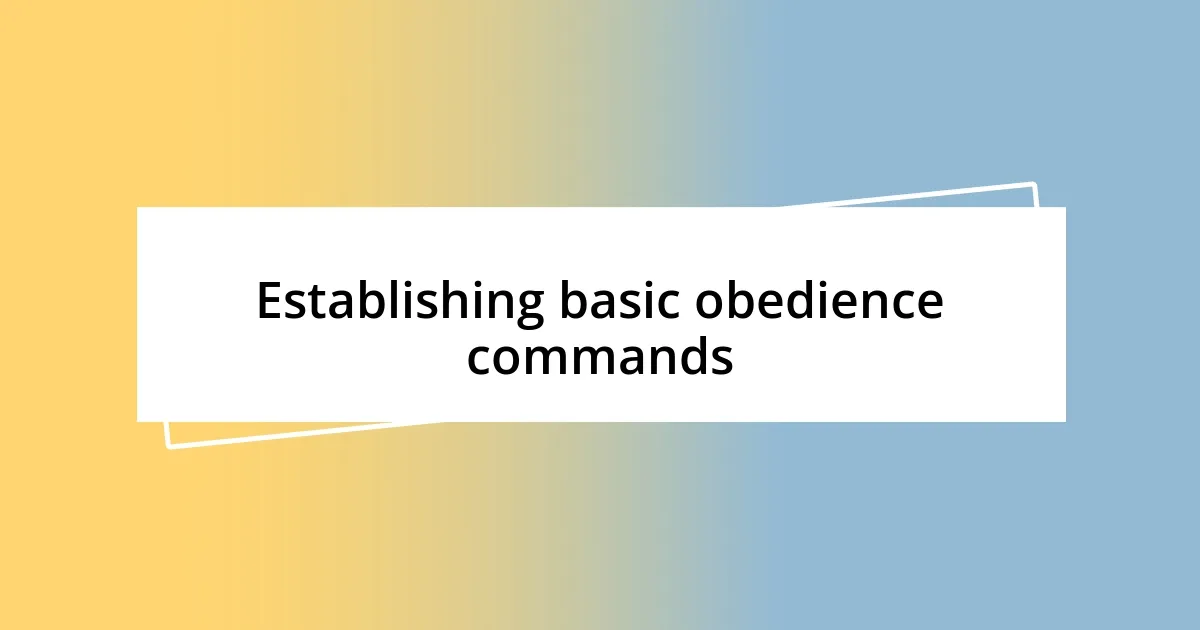
Establishing basic obedience commands
Establishing basic obedience commands was a game-changer in my journey with Max. Teaching him commands like “sit,” “stay,” and “come” wasn’t just about control; it was about understanding each other. I remember the moment Max first responded to “sit.” His ears perked up, and a spark of confidence lit up his face. This simple command not only strengthened our bond but also gave him a sense of purpose.
Here are some foundational commands to consider in your training:
- Sit: A great starting point. It offers structure and helps with impulse control.
- Stay: Essential for safety; it teaches dogs to wait in place.
- Come: Encourages your dog to return to you, reinforcing trust.
- Down: A calming position that can be useful in various situations.
- Leave it: Fosters good manners, preventing them from picking up harmful items.
I learned that patience is key. For Max, repetition was crucial. Some days, he nailed it instantly; other days felt like we were running in circles. But seeing his progress solidified my belief in establishing a routine, one that would make him feel secure and confident.

Socialization and exposure techniques
Socialization plays a pivotal role in helping rescue dogs like Max feel comfortable in new situations. When I first introduced him to other dogs at the park, I was nervous. Would he react fearfully or playfully? I remember one particular encounter with an exuberant Labrador. At first, Max froze, but with gentle encouragement and a slow approach, he eventually began to wag his tail, revealing a softer side I hadn’t seen before. It felt like a small victory—one that made me realize exposure to other dogs is crucial for building confidence.
Finding controlled environments for socialization can make all the difference. I took Max to puppy classes where he met both people and dogs in a safe setting. Watching him cautiously interact with other pups made my heart swell. It was during these sessions I learned the power of positive reinforcement. Every time he sniffed a new friend or engaged in play, I showered him with praise and treats. How could I not? These moments helped him forge connections and built up his trust in not just me, but in other beings around him.
The journey of socialization doesn’t stop once your dog has made some friends. I found it essential to expose Max to different environments—busy streets, quiet parks, and bustling cafes. Each outing served as a new experience, creating layers of comfort for him. It reminded me that change can be intimidating, even for humans. Hadn’t I felt out of place in unfamiliar situations myself? Each time Max navigated a new environment, I admired his resilience, which, in turn, inspired my own perseverance in our training journey.
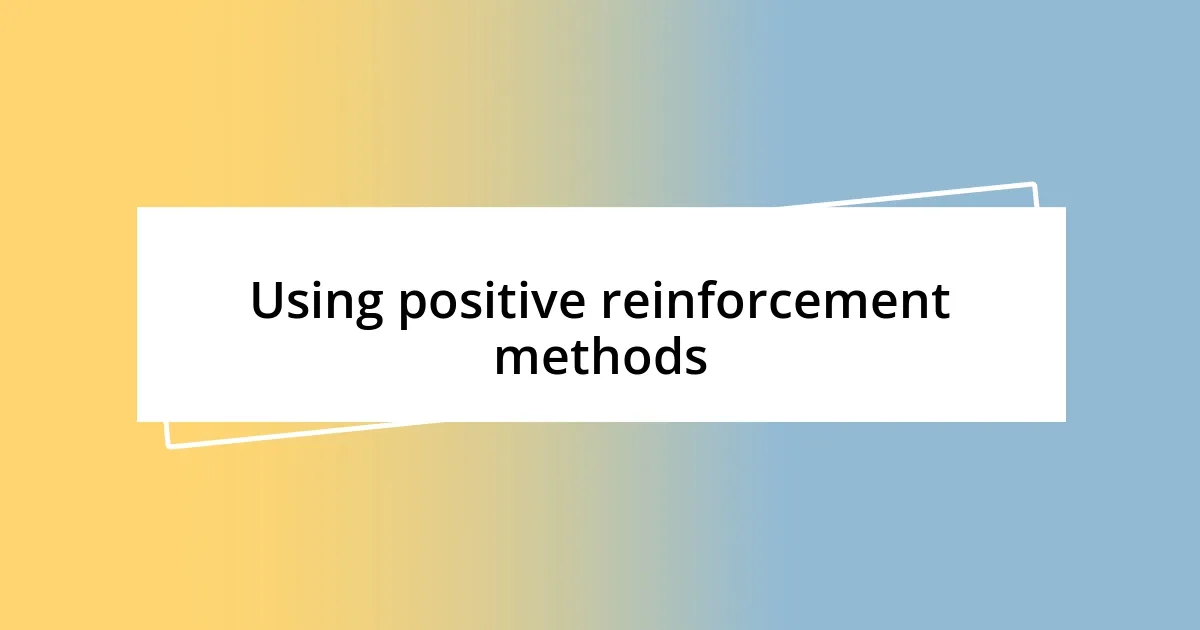
Using positive reinforcement methods
Positive reinforcement revolutionized my approach to training Max. Instead of using harsh corrections, I opted for treats and praise, which made a world of difference. I’ll never forget the first time he successfully sat on command and received a treat; his eyes sparkled with joy as if he understood he had done something special. It was a reminder of how effective encouragement can be.
As I continued this method, I found that consistency was crucial. Initially, I would reward Max every time he followed a command, but as he learned, I began to use variable rewards. This meant he wouldn’t always get a treat, but he would often receive verbal praise. This slight shift kept him engaged and eager to perform. Let’s face it, who doesn’t love a little unpredictability paired with affection?
One day, during our training session, a neighbor walked by with her dog, and without hesitation, I asked Max to “sit.” He did so perfectly, and I praised him wildly as bonus points! The satisfaction on his face when I tossed him a treat was priceless. It struck me then how powerful positive reinforcement can be—not just for training, but also for building a trust-based relationship. Watching Max blossom through encouragement made every moment spent training worthwhile. Have you ever had a similar experience with your dog that just melted your heart?
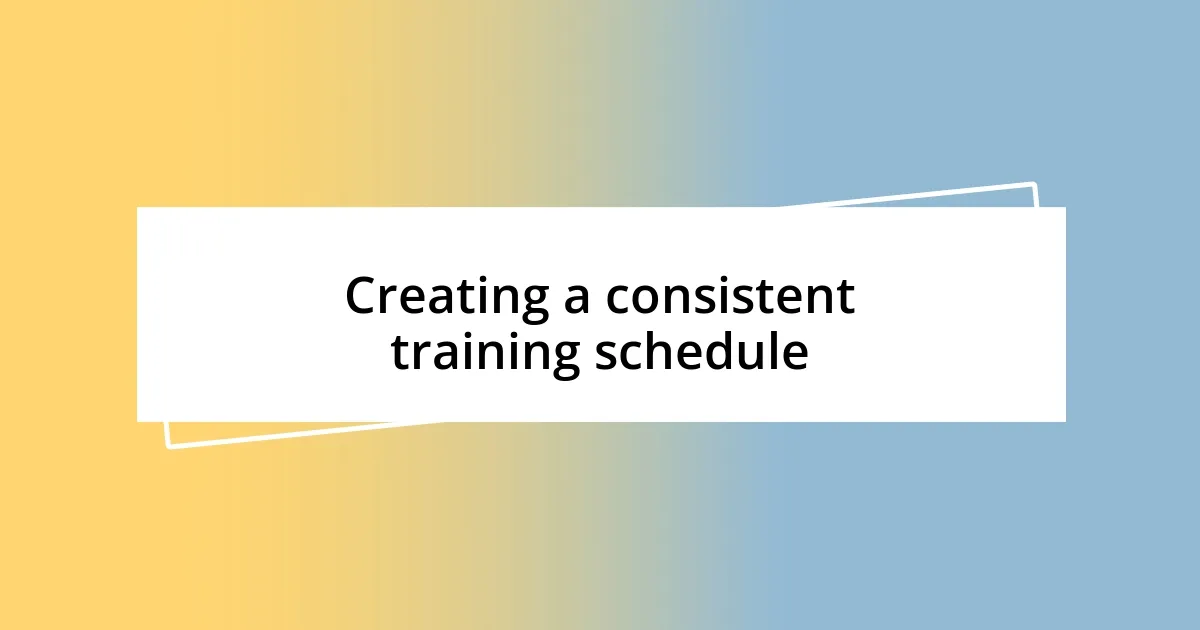
Creating a consistent training schedule
Establishing a consistent training schedule was a game-changer for me and Max. I quickly realized that regularity in our training sessions not only helped instill discipline but also made learning feel like part of our daily routine. Choosing specific times every day meant that neither of us had to second-guess when we’d dive into our training—this predictability created a safe space for Max, allowing him to focus and absorb what we were working on.
I settled on short sessions, usually around ten to fifteen minutes, to keep both of us engaged. Once, I made the mistake of extending a session because I enjoyed our time together. However, by the end, Max seemed restless and distracted, proving my point that less is often more. I learned that short, frequent sessions kept Max eagerly anticipating what we would tackle next. It’s fascinating how even dogs can get overwhelmed and lose interest, reminding me that quality matters significantly over quantity.
Another important aspect of consistency was integrating training into our everyday life. For instance, I started asking Max to “sit” before feeding him or when he wanted to go outside. These little moments reminded me that training isn’t just a task—it’s a part of our relationship. I often wonder, how can we make simple interactions more meaningful? The answer lay in making every moment a learning opportunity—it’s something I believe can transform your bond with your rescue dog just as it did with me and Max. Integrating training this way reinforced the idea that we were in this journey together.
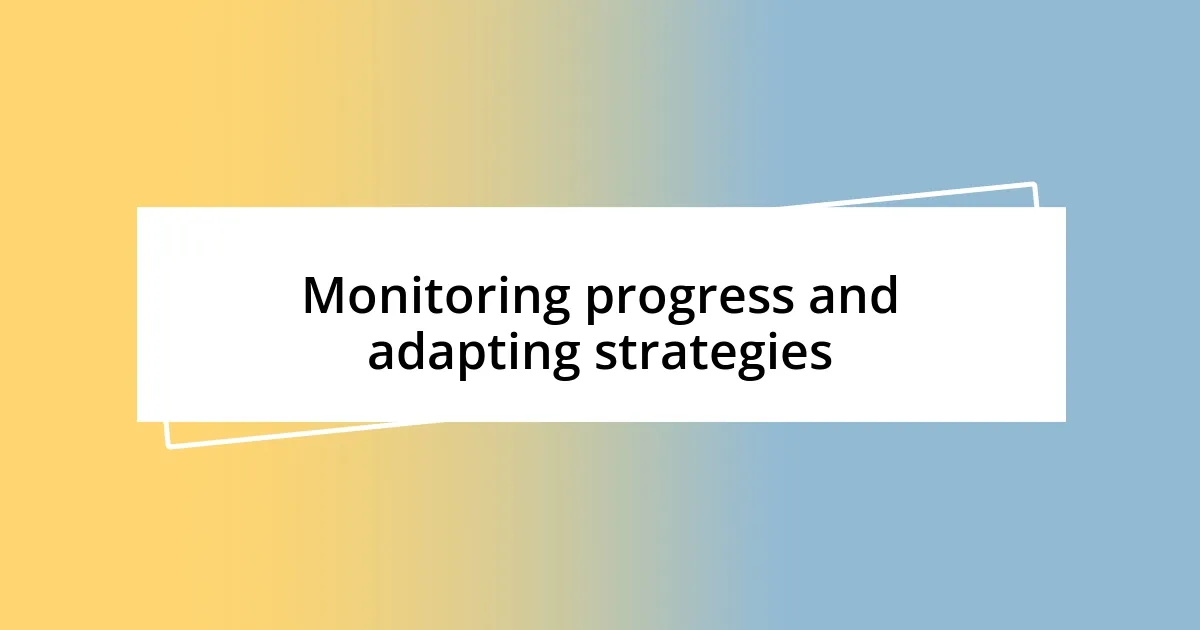
Monitoring progress and adapting strategies
Monitoring progress is an essential part of any training journey. For me, keeping track of Max’s achievements helped illuminate his growth. I began by jotting down milestones in a journal, and it was incredible to look back and see how far he had come—each small success, whether it was mastering “down” or staying calm around distractions, felt like a significant victory. Have you ever felt that thrill when you notice your dog is getting it? It’s those moments that make the effort feel worthwhile.
Adapting strategies became vital as I noticed Max’s responses change over time. I remember one particular afternoon when he was unusually restless during training. Instead of pushing through, I switched to a game of fetch as a break, and once we returned, he was re-energized and ready to learn again. Flexibility in approach is key—after all, learning should be an enjoyable experience for both of us. It made me realize: how often do we overlook the need for variation in our training methods?
Incorporating new techniques not only refreshed our sessions but also kept Max excited and engaged. For instance, I introduced clicker training after a few weeks; the sound became a signal of motivation to him. Many times, I found myself celebrating how quickly he adapted to changing strategies. This showed me that when we embrace the unexpected in training, we can make growth even more rewarding! Have you ever considered how altering your approach could lead to new breakthroughs for your dog? It’s a valuable lesson I learned through my journey with Max.












